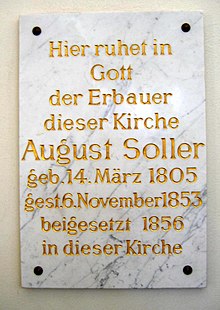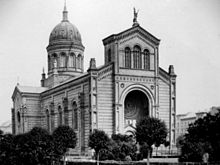August Soller
August Soller | |
|---|---|
 Soller's grave inscription at Saint Michael's Church, Berlin, 1856 | |
| Born | Johann August Karl Soller 14 March 1805 |
| Died | 6 November 1853 (aged 48) |
| Alma mater | Bauakademie |
| Occupation | Architect |
| Spouse | Friederike Wilhelmine |
| Children | 8 |
| Buildings | Luisenstädtische Kirche St. Michael's Church, Berlin |
Johann August Karl Soller (14 March 1805 – 6 November 1853) was a
Life and work
August Soller was born in Erfurt, Principality of Erfurt, in 1805. He worked as a land surveyor from 1820–1822 and completed his surveyor's examination on June 22, 1822 at the E. S. Unger Mathematical Institute. Soller then completed two and a half years of practical experience as a building inspector. To prepare for his master builder's examination, he moved to Berlin and lived with the family of his nephew Richard Lucae.[4]

In 1829 Soller was licensed as a Prussian state architect. He then served in the provinces, particularly in the Province of Silesia. From 1830 to 1833 he worked as a royal construction foreman for the District Government in Liegnitz and for a time served as a construction inspector in Posen. His focus became the design of churches and the supervision of their construction. On June 1, 1833, he became a master builder for the Prussian Higher Council of Architecture (German: Preußische Oberbaureputation) in Berlin and also became a member of the Berlin Academy of Architecture, known as the Bauakademie.[5] During this period Soller was assistant to Karl Friedrich Schinkel, one of the most prominent architects in Germany. Soller took over the Department of Churches in the Construction Commission in 1841, and in 1843 was made Senior Privy Councillor (German: Geheimer Oberbaurat) for Infrastructure. From 1851 onwards he served as Lead Councillor for construction in the Prussian Ministry of Trade.[6]
His first completely independent work was the nearly three meter high tomb of General

Soller's most important work is
Legacy

Since his health was poor and he died at only 48 years old, Soller's oeuvre is not as extensive as it might have been. His designs for the spire of the Jerusalemer Kirche (1837) and the Petri- und Markuskirche (1844), for instance, were never carried out. However, he is regarded as the best among the state architects of the period. He sought neither fame nor honors, instead dedicating himself to principles of sound architectural design.[5]
As Soller's work became known through publications, it influenced American architects
A number of Soller's significant works were damaged in World War II and demolished in its aftermath. St. Michael's was heavily damaged on the night of Feb 3, 1945 during the bombing of Berlin. It was stabilized and partially restored between 1948 and 1953, with the installation of a worship space in the transept. More repair and restoration work continued between 1976 and 1998, although the front façade and nave remain a ruin.[10] The Invalidensäule survived the war without significant damage, but it became overshadowed by more pressing events surrounding the Berlin Blockade. It was demolished by the city on August 19, 1948. The Luisenstädtische Kirche burnt during the bombings of February 3, 1945, with Soller's west tower still standing. However, by 1961 the church's ruins were located in the boundary strip of the Berlin Wall and it too was demolished in 1964. The foundations still remain in the former cemetery, which is now a park.[13]
Gallery
-
Church of St. Marien am Behnitz, Berlin-Spandau (1848)
-
Church of St. Marien am Behnitz as restored in 2006
-
Luisenstädtische Kirche (1845), memorial plaque at the site
-
Invalidensäule (1853), front elevation
-
St. Michael's Church, Berlin
Writings
- Soller, August: Entwürfe zu Kirchen, Pfarr- und Schul-Häusern zum amtl. Gebr. bearb. u. hrsg. von der Kgl. Preuss. Ober-Bau-Deputation. Potsdam: Riegel Lfg. 1 (1844) bis Lfg. 13 (1855)
References
- ^ "Soller, August." Deutsche Biographie (in German). Retrieved 19 Jan 2017.
- LCCN 04010947.
- ^ ISBN 0-521-79306-8.
- ISBN 3791303481.
- ^ JSTOR 988874. Retrieved 19 Jan 2017.
- ^ ISBN 9783110966299.
- ISBN 978-3894791179.
- ^ Thieme, Ulrich; Becker, Felix (1937). Allgemeines Lexikon Der Bildenden Kunstler Von Der Antike Bis Zur Gegenwart. Vol. 31. Leipzig: E. A. Seemann. p. 254.
- ISBN 0-271-02215-9.
- ^ a b "Geschichte der St. Michael Kirche" (in German). Der Förderverein zur Erhaltung der Katholischen Kirche St. Michael (Foundation for the Preservation of the Catholic Church of St. Michael's). Retrieved 19 Jan 2017.
- ISBN 3-433-00995-3.
- ISBN 9783035610093.
- ^ "Luisenstädtische Church" Berlin Lexicon, Edition Luisenstadt 2002 (in German). Retrieved 20 Jan 2017.
Further reading
- Erbkam, Georg: August Soller (Nekrolog). In: Zeitschrift für Bauwesen, 4. Jahrgang 1854, pp. 105–108. Full obituary online (in German).





